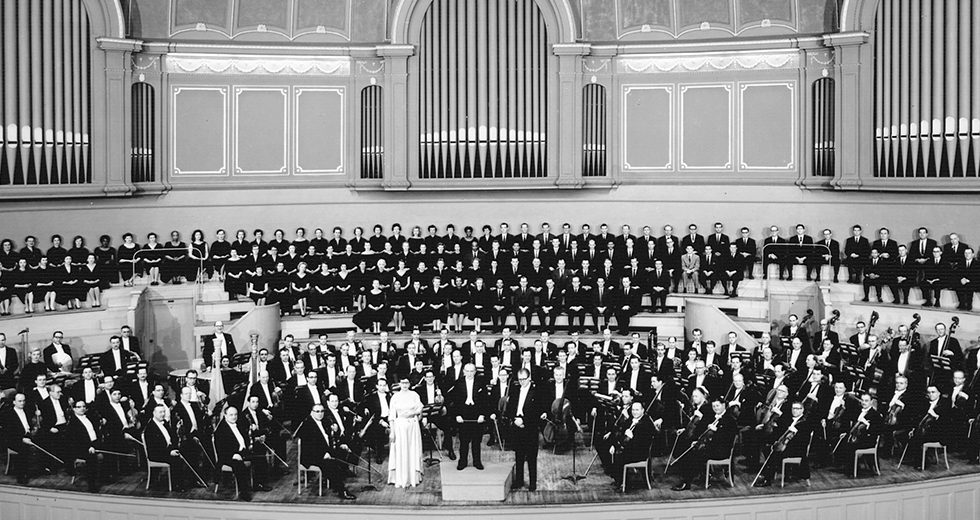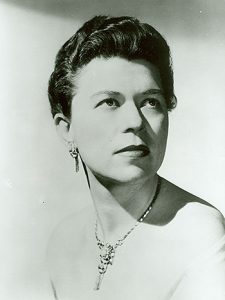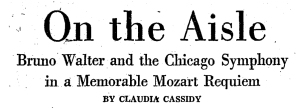
One of Fritz Reiner’s primary goals, early in his tenure as the Chicago Symphony Orchestra’s sixth music director, was to program major choral works. However, the repertory he wished to perform was, in his opinion, too demanding for the amateur and student groups usually engaged.
While visiting New York in February 1954, Reiner observed a rehearsal of the New York Concert Choir, under the direction of its founder, Margaret Hillis. He was so impressed that on his return to Chicago, Reiner convinced the board of trustees to hire Hillis and her ensemble for performances the following season of Barber’s recently composed Prayers of Kirkegaard and Orff’s Carmina burana, both new to the Orchestra’s repertoire. (For performances of Beethoven’s “less demanding” Ninth Symphony, the local Swedish Choral Club was engaged.)
Hillis and the New York Concert Choir first traveled to Chicago in March 1955 for three performances of the works by Barber and Orff. Roger Dettmer, writing for the American, exclaimed, “it was Miss Hillis’s magnificent choir of sixty which matched most closely the Orchestra’s astonishing virtuosity by giving Dr. Reiner the fullest measure of choral artistry.” In the Daily News, Irving Sablosky added, “We’re not used to hearing choral singing of such refinement and nuance in symphony concerts. I hope we’ll hear more.”
Despite scheduling challenges, Reiner reengaged Hillis the following season for Mozart’s Mass in C minor and Bruckner’s Te Deum in January 1956. Dettmer wrote that the Orchestra and “Margaret Hillis’s magnificent [choir], easily the finest professional chorus in this country today, [performed] with uncommon brilliance, and maestro himself was in supremely spirited command.”
For the 1957–58 season, Reiner hoped to perform and record Verdi’s Requiem, and again he contacted Hillis. The New York Concert Choir averaged only sixty voices, and she informed Reiner they would need nearly double that in order to do justice to the Verdi. It would simply be too expensive.
This impasse gave Reiner an idea. He persuaded board president Eric Oldberg to hire Hillis to organize a chorus permanently affiliated with the Orchestra in Chicago. She initially agreed to advise on how to audition a director and choristers, but Reiner insisted there would be no chorus unless Hillis herself was the director. At the trustees meeting on September 20, 1957, Oldberg reported on successful negotiations and the plan to hire Hillis was approved.
“As choral literature takes on increasing importance in the orchestral sphere, the Chicago Symphony is making its move to institutionalize the trend,” wrote Seymour Raven in the Chicago Tribune on September 22. “From Orchestra Hall comes word that the Chicago Symphony Orchestra Chorus is to be a new factor in the city’s musical life.”
Auditions began on October 5, and in less than two weeks the Sun-Times reported that they had “produced an exceptionally high rate of successful applicants. . . . Skill in sight-reading, interpretative ability, and voice quality were the main prerequisites for success. Voices with a tremolo or breathless quality were automatically rejected.” On October 13, the Daily News advertised that auditions were continuing: “Men’s voices are still urgently needed.”
The Chicago Symphony Chorus, nearly one hundred voices strong, began rehearsals on October 28, and on November 30, the ensemble made an informal debut at a private concert for guarantors and sustaining members. On the first half of the concert, Reiner led Cailliet’s orchestration of Bach’s Little G minor fugue and Strauss’s Oboe Concerto (with principal Ray Still), and after intermission, Hillis took the podium, becoming the first woman to conduct the Chicago Symphony Orchestra. She led the Orchestra and Chorus in Thompson’s Alleluia and Billings’s Modern Music (both a cappella), the final section of Purcell’s Ode for Saint Cecilia’s Day, and the Servants’ Chorus from Donizetti’s Don Pasquale. Dettmer reported in the American that the debut was “more than promising . . . Miss Hillis’s choristers were fresh-voiced, musically sensitive, already balanced internally . . . she has accomplished much in the briefest time span.”
When popular guest conductor Bruno Walter informed the Orchestral Association that his March 1958 appearances would be his last in Chicago, Oldberg insisted that he should lead Mozart’s Requiem with the new chorus as his swansong. To prepare for both sets of concerts, Hillis and the Chorus began their work in earnest on Mozart’s and Verdi’s requiems, with Reiner regularly attending rehearsals.
On March 13 and 14, 1958, the Chicago Symphony Chorus made its official debut in Mozart’s Requiem, under Walter’s baton with soloists Maria Stader, Maureen Forrester, David Lloyd, and Otto Edelmann. In the Chicago Tribune, Claudia Cassidy wrote: “The Chicago Symphony Orchestra is in high estate, with the kind of clairvoyance that gives a conductor what he wants in sound. . . . The evening’s card up the Mozartean sleeve was the new Chicago Symphony Orchestra Chorus of about 100 voices, expertly chosen and admirably trained by Margaret Hillis. It had balance and hints of brilliance, it was adroit in attack and it had moments of reassuringly imaginative song. The Confutatis in particular caught the haunted terror that was Mozart’s when the mysterious commission for the Requiem convinced him that the death knell he wrote was his own.”

Program page for Verdi’s Requiem, performed on April 3 and 4, 1958. It was repeated the following Tuesday, April 8.
Less than a month later, the Chorus appeared in Verdi’s Requiem with Reiner conducting and soloists Leonie Rysanek, Regina Resnik, David Lloyd, and Giorgio Tozzi. In the Sun-Times, Robert C. Marsh wrote that “Miss Hillis’s chorus proved its virtues earlier this season. Again its excellent enunciation, reliable intonation, and intelligent response were praiseworthy.”*
The following season, at Reiner’s invitation, Hillis conducted the Orchestra and Chorus in Honegger’s Christmas Cantata in December 1958. In the Daily News, Donal Henahan wrote, “Miss Hillis, who has been until now unknown except by name to most symphony subscribers, ruled her vast forces with a firm beat and a sure hand.” And the critic in the American noted, “With a clear (if inflexible) beat, Miss Hillis marshalled her forces, choral and orchestra, in a tight, sensitive, sweet-sounding statement of the music. . . . All in all, a glorious Christmas program.”
Later that season in March 1959, Reiner led Prokofiev’s cantata Alexander Nevsky. “The climactic ‘Battle on the Ice’ was approached with expansive calm and deliberation. . . . A conductor who tries to pile climax after climax into this work can never achieve the hair-raising thrust that Reiner drew from Margaret Hillis’s Chicago Symphony Chorus at such a moment,” observed Henahan in the Daily News. The Chorus “produced a pleasing sound in all voices and a more homogeneous tone than at any time since Miss Hillis began her missionary work in Chicago.” On March 7, Reiner, the Orchestra, and Chorus committed their performance to disc for RCA, collaborating for the first time in recording sessions.

The Chorus’s first recording with the Orchestra: Prokofiev’s Alexander Nevsky, released by RCA in May 1960
Margaret Hillis directed the Chicago Symphony Chorus for thirty-seven years, preparing and leading concerts—in Orchestra Hall and at the Ravinia Festival, as well as on tour to Carnegie Hall, London’s Royal Albert Hall, and Salzburg’s Grosses Festspielhaus—and amassing an award-winning discography. Following her death in February 1998, the Rosenthal Archives received her collection of papers, photographs, over 1,000 scores bearing her markings, awards (including nine Grammy statuettes), recordings, and memorabilia. Representing an exceptional and pioneering career, the collection is regularly accessed by researchers, scholars, and musicians.
In June 1994, following an international search, music director Daniel Barenboim appointed Duain Wolfe to succeed Hillis. Currently in his twenty-fourth season, Wolfe continues in Hillis’s tradition, maintaining the Chorus’s extraordinarily high standards of excellence.
*Due to scheduling conflicts, Reiner was unable to get the soloists—primarily Zinka Milanov and Jussi Björling—he wanted to record Verdi’s Requiem in Chicago. He, along with Leontyne Price, Rosalind Elias, Björling (in his last commercial recording), and Giorgio Tozzi, recorded it in Vienna in June 1960 with the Vienna Singverein and Philharmonic for RCA.
TOP: The Chicago Symphony Orchestra and Chorus onstage in March 1959. Also pictured is chorus director Margaret Hillis, music director Fritz Reiner, and associate conductor Walter Hendl. | Photo: Oscar Chicago
This article also appears in the Chicago Symphony Orchestra’s March 2018 program book and here.




